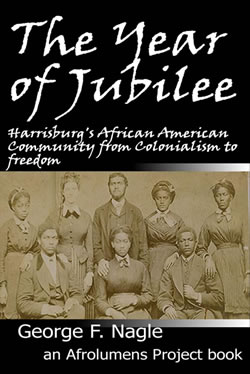
a book about Harrisburg...
by George F. Nagle
Study Areas:
Part
Three
Approaching Storms
Chapter
Seven
Rebellion
1820s
Sometime between the establishment of the African church and the mixed race Sabbath School, and the enumeration of the African American population of Harrisburg by federal census takers in the Third Census of the United States, quite a few new black families had established themselves in this town on the Susquehanna River. The census takers in 1820 recorded substantial increases in the size of the black community in the Borough of Harrisburg from the previous census ten years before, counting 176 free blacks and one slave, with nearly three-quarters of the free blacks now residing in households headed by an African American.12
During that same time period, many other important changes had come to Harrisburg—changes that would affect the borough in a very positive manner. In the intervening years, Harrisburg had become the new capital of the Commonwealth of Pennsylvania, and John Harris’ public ground was chosen as the site of the new capitol building. Legislators began arriving in Harrisburg in 1812 to conduct the state’s business from the county courthouse on the corner of Market Street and Court Alley, and continued working from that public building until the new capitol was ready for occupancy in early 1822. They lodged and took meals in nearby hotels when they were in session, used local livery stables, bought products from local merchants, and patronized local craft and service providers.
A year after the state legislators began doing business in the new capital, construction began on the first bridge to span the Susquehanna at this location. The desire for a bridge connecting the east and west shores of the river was expressed by local citizens as early as 1809, but the necessity of a bridge became apparent during the War of 1812, when the movement of men and supplies across the commonwealth sometimes became bogged down at Harrisburg by the slow, weather-dependent ferries. State legislators, who now bore witness to the slow and dangerous river crossings, chartered the Harrisburg Bridge Company during their first year in Harrisburg. The newly chartered company promptly hired architect Theodore Burr to span the wide Susquehanna. Bridge construction began in 1813. Four years later, the Market Street Bridge officially opened for business, and farmers and merchants from the Cumberland County side of the river eagerly paid a toll to bring their wares and produce across the bridge to the residents of Harrisburg.
Transportation in and out of Harrisburg improved dramatically in the years between the second and third national censuses. Spurred by the need to connect the new capital with the rest of the commonwealth, the legislature authorized the construction of five turnpikes beginning in 1810. Most were complete and in operation by 1820. Stagecoach operator William Calder, Sr., who had government contracts to carry mail, followed the legislature and moved his business from Lancaster to Harrisburg in 1812. He expanded his business to carry passengers from his depot on the northwest corner of Market Square, substantially improving the speed and comfort of travel between Harrisburg and nearby towns.13
Despite these very significant and fortunate developments, Harrisburg’s population of European-descended residents increased only modestly between 1810 and 1820, from just over 2200 residents to about 2800 residents. Although vastly outnumbering the town’s African-descended residents, Harrisburg whites were alarmed to see the size of the black community grow from less than three percent of the population, to nearly six percent.14
This general unease among Harrisburg whites at seeing the local African American community prosper and grow may have been increased by a corresponding change in the status of Harrisburg blacks. In addition to increased numbers, African Americans began taking a much larger role in the daily business of Harrisburg, occupying many more levels of the social structure beyond servants and slaves. White residents of Harrisburg began to interact with black residents as merchants, barbers, carpenters, pastors, and restaurateurs. Blacks slowly began to become intertwined with the necessary daily services and goods that nourished the growing town. White householders became dependent upon black chimneysweeps to keep their chimneys clear and safe from a deadly fire. Business owners and householders alike looked to black drivers to deliver the hickory or oak wood and later the coal that fired their ten-plate stoves, hearths, and bake ovens. Housewives paid black entrepreneurs fifty cents for a barrel of river water to do the day’s laundry. Black laborers moved furniture, tore down old buildings, hauled away ashes, repaired streets, and loaded wagons, while black maids cleaned parlors, cooked meals, and looked after white children. All these services were now performed by free people, not indentured servants or slaves, and for these services, they were paid wages that had to be negotiated. That need for negotiation, a new wrinkle in the fabric of race relations in Harrisburg, increased the power and social standing of blacks.
African Americans even influenced the early culinary habits of Harrisburg’s residents by introducing new foods and by supplying a wide variety of otherwise unobtainable foods. The first use of tomatoes as a food in Dauphin County, rather than as decorative plants, occurred in 1814 through the instruction of an African American woman in York. The woman, described only as a "West India negro," had supplied tomatoes to a York tavern keeper who served them stewed according to her recipe. Prior to this, tomatoes were grown in Harrisburg by William Maclay in his gardens at Front and South Streets, but they were grown strictly as decorative plants, as the stalks and particularly the fruits were believed to be poisonous. It was not until local militiamen, returning from York where they were stationed during the War of 1812, talked about a delicious dish that was being served in one of that town's finer taverns. Colonel John Roberts, who was then an orderly sergeant in Captain Walker's company of the first battalion, had dined on stewed tomatoes while in a York tavern and "found them excellent.” When he inquired about the dish, he was directed to the African American woman who gave him seeds and recipes on how to prepare the ripe fruit. A year later Roberts' own plants, begun from tomato seeds from this woman, began yielding the tomatoes that became the first to be eaten in Harrisburg.
Tomatoes were hardly the only food affected by African American influence, though. In later years, the town’s markets were enriched by a wider variety of seafood and fresh vegetables, brought from Philadelphia by Curry Taylor, who had come to Harrisburg from Columbia in neighboring Lancaster County. Prior to the advent of the railroads in Harrisburg, shad and fresh oysters were brought to market in wagons from York. Those were the only seafood items available to Harrisburg cooks until Curry Taylor, a baker and caterer, bought a wagon and began making trips to Philadelphia twice a week for fresh fish and vegetables. Taylor brought black sea bass and halibut, as well as a wide variety of fresh vegetables, to his stall in the lower market house on the square.15 Curry Taylor’s fresh produce stand is one example of how Harrisburg blacks increased their social standing through entrepreneurship, but his success was founded on the work of an earlier pioneering generation of African American businessmen.
Notes
12. Eggert, “Two Steps Forward,” 3.
13. Steinmetz
and Hoffsommer, This Was Harrisburg, 64-66; Gerald G. Eggert, Harrisburg
Industrializes: The Coming of Factories to an American Community (University Park: Pennsylvania State University Press, 1993), 17-21.
Some reminiscences in Egle’s Notes and Queries note that Calder’s
stages departed from in front of the Spread Eagle, later called the Golden
Eagle Hotel, on the northeast corner of Market Square. This site later
became the Bolton Hotel. See Notes and Queries, First and
Second Series, vol. 1, 42:301 and Annual Volume 1899, 8:36.
14. Eggert, “Two Steps Forward,” 3.
Of the changes in population
between 1810 and 1820, historian William Henry Egle, writing in the late
1800s noted, “During the next decade, notwithstanding the removal
of the seat of government of the State here, the population had not increased
very rapidly….[however] It will be seen that the colored population
more than doubled itself.” Egle, Notes and Queries,
29:184-5.
15. Kelker,
History of Dauphin County, 101; Egle, Notes and Queries,
17:97.
Caution: Copyrighted material. Published September 2010.
© 2010 George F. Nagle
This is the first in a series of books from the Afrolumens Project. Drawing on a large number of sources, and making good use of the treasure trove of information on the pages of the Afrolumens Project, this is the first truly comprehensive history of Harrisburg's African American community.

